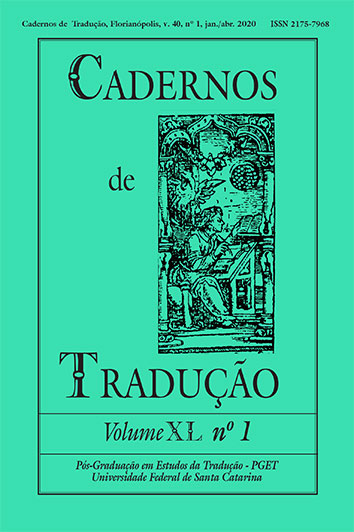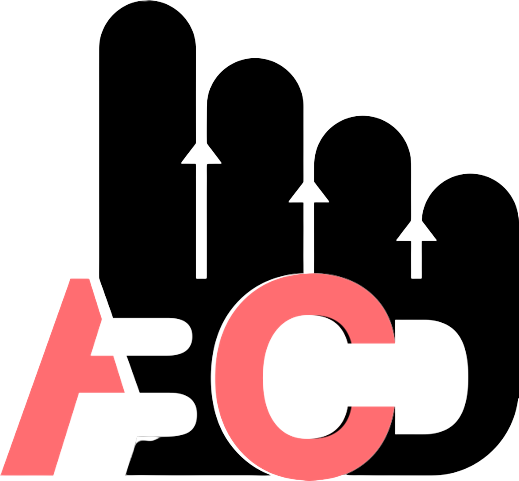Como seria uma sociologia aplicada aos estudos da tradução?
DOI:
https://doi.org/10.5007/2175-7968.2020v40n1p440Resumo
O presente artigo tem por objetivo elencar algumas das principais vertentes sociológicas a fim de associá-las, de maneira produtiva, aos Estudos da Tradução de forma a promover o conceito de Sociologia Aplicada à Tradução (SAT). Esse rótulo foi escolhido porque buscamos destacar a oportunidade de atrair recursos, métodos e ferramentas de outros campos epistemológicos (os das Ciências Sociais) e realizar uma apropriação seletiva deles para o nosso âmbito disciplinar. Para tanto, traçamos um breve panorama de estudos, como os de Wolf (2002), Inghilleri (2003), Sapiro (2007), Sela-Sheffy (2005), Thoutenhoofd (2005) e Gouanvic (2007), entre outros, os quais fundamentam suas análises em conceitos advindos das diferentes leituras socioculturais. Dessa forma, compreendemos que tais leituras compartilham de uma estrutura metodológica e permitem conceber hipóteses válidas além de momentos específicos no tempo, espaços territoriais ou agentes sociais. Esta proposta irá inspirar a continuação e a réplica de pesquisas, e esperamos que essa inspiração se torne uma tarefa coletiva realizada por nossa área, com o intuito de promover a evolução da SAT.
Referências
Akrich, M.; Callon, M.; Latour, B. Sociologie de la traduction: Textes fondateurs. Paris: Presses de l’ecole des Mines, 2006.
Angelelli, C.V. Revisiting the Interpreter’s Role. A study of conference, court, and medical interpreters in Canada, Mexico and the United States. Amsterdam/Philadelphia: John Benjamins, 2004.
Argüés, C. (Ed.) Primeras chornadas sobre a traduzión: o papel d’a traduzión em o desembolique d’as luengas: o caso de L’aragonés. Zaragoza: Instituto de Estudios Altoaragoneses & Gara d’Edizions, 1998.
Baxter, R.N. “El paper de la traducció en la consolidació de la percepció social del gallec com a Abstandsprache”. Quaderns, [s.l], 7, 2002, p. 167-181.
Blommaert, J. “Bourdieu the Ethnographer: The Ethnographic Grounding of Habitus and Voice”. The Translator, [s.l], 11, v.2, 2005, p. 219-236.
Bourdieu, P. “Genèse et structure du champ religieux”. Revue Française de sociologie, [s.l], 12, 1971(a), p. 295-334.
Bourdieu. P. Esquisse d’une théorie de la pratique précédèe de trois études d’ethnographie kabyle. Geneva: Droz, 1972(b).
Bourdieu, P. Le sens pratique. Paris: Éditions de Minuit, 1980(c).
Branchadell A.; Lovell, M.W. (Eds.) Less translated languagens. Amsterdam: John Benjamins, 2005.
Buzelin, H. “Unexpected Allies: How Latour’s Network Theory Could Complement Bourdieusian Analyses in Translation Studies”. The Translator, [s.l], 11, 2, , 2005, p. 193-218.
Chesterman, A. “Questions in the Sociology of Translation”. In: Ferreira Duarte, J.; Assis Rosa, A.; Seruya, T. (Eds.) Translation Studies in the Interface of Disciplines. Amsterdam/Philadelphia: John Benjamins, 2006, p. 9-28.
Colomer, J. M. “To translate or to learn languages? An evaluation of social efficiency”. International Journal of the Sociology of Languages, [s.l], 121, 1996, p. 181-197.
Corbeil, J. “Relation entre traduction, développement et aménagement linguistique”. Turjuman, [s.l], 1, 2, 1992, p. 7-16.
Cronin, M. Altered States: “Translation and Minotiry Languages”. TTR VII, [s.l], 1, 1995, p. 85-103.
Davidson, B. “The Interpreter as Institutional Gatekeeper: The Social-linguistic Role of Interpreters in Spanish-English Medical Discourse”. Journal of Sociolinguistics, [s.l], 4, 3, 2000, p. 379-405.
De Andrade, “O. Manifesto Antropofágico”. In: De Andrade, O. Obras completas. Do Pau Brasil à antropofagia e às utopias: Manifestos, teses de concursos e ensaios. Rio de Janeiro: Civilização Brasileira, 1928 [1970].
Diaz-Fouces, O.; González, M.G.; Carreras, J.C. (Eds.) Tradicció i dinámica sociolingüísticaa. Barcelona: Llibres de l’índex, 2002.
Erkazanci, H. “Language Planning in Turkey: a Source of Censorship on Translations”. In: Seruya, T; Moniz, M.L. (Eds.) Translation and Censorship in Different Times and Landscapes. Newclaste: Cambridge Scholars Publishing. 2008, p. 241-251.
Espriu, S. Primera História d’Esther. The Story of Esther (The Anglo-Catalan Society Occasional Publications). Translated by P. Polack. Sheffield: Sheffield Academic Press, 1989.
Fujii, A. “New Translation in Japan”. Meta, Canada, 33, 1, 1988, p. 32-37.
Gambier, Y. “Pour une socio-traduction”. In: Ferreira Duarte, J.; Assis Rosa, A.; Seruya, T. (Eds.). Translation Studies at the Interface of Disciplines. Amsterdam/Philadelphia: John Benjamins, 2006, p. 29-42.
García, M. “Socioloxías do saber común: interpretación e a metáfora do teatro (Na busca dun modelo aplicable á predicción de elementos verbais e non verabis nos discursos interpretables)”. Traducción & Comunicación, [s.l], 3, 2002, p. 35-65.
Garfinkel, H. Studies in ethnomethodology. Englewood Cliffs, New Jersey: Prentice-Hall, 1967.
Goffman, E. The presentation of self in every day life. Edinburgh: University of Edinburgh Press, 1956.
Gouanvic, J. “Translation and the Shape of Things to Come: The Emergence of American Science Fiction in Post-War France”. The translator, [s.l], 3, 2, 1997(a), p. 123-132.
Gouanvic, J. Sociologie de la Traduction: La Science-fiction Américaine dans L’espace culturel français des Annés 1950 (Traductologie). Arras: Artois Presses Université, 1999(b).
Gouanvic, J. A “Bourdieusian Theory of Translation or the Coincidence of Practical Instances. Field, ‘Habitus’, Capital and ‘Ilusio’”. The Translator, [s.l], 11, 2, 2005(c), p. 147-166.
Gouanvic, J. “Objectivation, réflexivité et traduction: Pour une relecture bourdieusienne de la traduction”. In: Wolf, M.; Fukari, A. (Eds.) Constructing a Socilogy of Translation. Amsterdam: John Benjamins, 2007(d), p. 79-92.
Hanna, S. F. “Hamlet Lives Happily Ever After in Arabic: The Genesis of the Field of Drama Translation in Egypt”. The Translator, [s.l], 11: 2, 2005, p. 167-192.
Hautanen, S. “The Work Process of a Correspondent: A Case Study in Translation Sociology”. In: Conway, K.; Bassnett, S. (Eds.) Translation in Global News. Proceedings of the conference held at the University of Warwick 23 June 2006. Warwick: University of Warwick - Centre for Translation and Comparative Cultural Studies. 2006, p. 105-112.
Heilbron, J.; Sapiro, G. “Traduction: les échanges littéraires internationaux”. Special issue of Actes de la recherche en sciences sociales 144, 2002.
Heilbron, J.; Sapiro, G. “Outline for a sociology of translation: Current issues and future prospects”. In: Wolf, M.; Fukari. A. (Eds.) Constructing a Sociology of Translation. Amsterdam: John Benjamins, 2007, p. 93-107.
Heinich, N. “Les traducteurs littéraires: l’art et la profession”. Revue française de sociologie, [s.l], 25, 1984, p. 264-280.
Hursti, K. “An insider’s view on transformation and transfer in international news communication: an English-Finnish perspective”. The Electronic Journal of the Department of English at the University of Helsinki, [s.l], 1, Translation Studies, 2001.
Inghilleri, M. “Habitus, Field and Discourse: Interpreting as a socially situated activity”. Target, [s.l], 15, 2, 2003(a), p. 243-268.
Inghilleri, M. “Bourdieu and the Sociology of Translation and Interpreting”. In: Inghilleri, M. The Translator. Manchester: St. Jerome, 2005a(b). p. 125-146.
Inghilleri, M. “The Sociology of Bourdieu and the Construction of the ‘Object’ in Translation and Interpreting Studies”. In: Inghilleri, M. The Translator. Manchester: St. Jerome, 11, 2, 2005b(c), p. 125-145
Jaffe, A. “Locating Power: Corsican Translators and Their Critics”. In: Blommaert, J. (Ed.) Language Ideological Debates. Berlin/New York: Mouton de Gruyter, 1999, p. 39-66.
Kahane, E. “La interpretación de conferencias o el teatro como metáfora”. Cuadernos Hispanoamericanos. [s.l], 431, 1986, p. 175-190.
Lewin, K. “Action-research and minority problems”. Journal of Social Issues, [s.l], 2, 4, 1946(a), p. 34-46.
Lewin, K. “Frontiers in Group Dynamics: II. Channels of Group Life; Social Planning and Action Research”. Human Relations, [s.l], 1, 2, 1947(b), p. 143-153.
Mikkelson, H. Interpreting is interpreting - Or is it? ACEBO, 2001.
Millán-Valera, C. “Translation, Normalisation and Identity in Galicia(n)”. Target, [s.l], 12, 2000, p. 267-282.
Monzó, E. La professió del traductor jurídic i jurat. Descripció sociológica de la professió i anàlisi discursiva del transgènere. Barcelona, Castellón: CESCA, Universitat Jaume I, 2002.
Monzó, E. “Un marc per a la visibilització del traductor: reflexions des de la traducció jurídica i jurada”. Traducción & Comunicación, [s.l], 4, 2003, p. 55-84.
Niska, H. The Interpreter as a Language Planner. Stockholm: Stockholm University, 1998.
Nord, C. Textanalyse und Übersetzen. Theoretische Grundlagen, Methode und didaktische Anwendung einer übersetzungsrelevanten Textanalyse. Heidelberg: Groos, 1988.
Paquin, R. “Le doublage au Canada: politiques de la langue et langue des politiques”. Meta XLV, 1, 2000, p. 127-133.
Parsons, T. The Structure of Social Action: A Study in Social Theory. New York: McGraw Hill, 1937.
Pöchhacker, F. “‘Going social?’ On pathways and paradigms in Interpreting Studies”. In: Pym, A.; Shlesinger, M; Jettmarová, Z. (Eds.) Sociocultural Aspects of Translating and Interpreting. Amsterdam/Philadelphia: John Benjamins, 2006, p. 215-232.
Pym, A. “Introduction: On the social and cultural in translation studies”. In: PYM, A.; Shlesinger, M.; Jettmarová. Z. (Eds.) Sociocultural Aspects of Translating and Interpreting. Amsterdam/Philadelphia: John Benjamin, 2006, p. 1-25.
Rodríguez Morató, A. La problemática profesional de los escritores y traductores. Una visión sociológica. Barcelona: Associació Collegial d’Escriptors de Catalunya, 1997.
Rudvin, M. “Professionalism and ethics in community interpreting”. Interpreting, [s.l], 9, 1, 2007, p. 47-69.
Sacks, H.; Schegloff, E.A.; Jefferson, G. “A simplest systematics for the organization of turn-taking for conversation”. Language, [s.l], 50, 1974, p. 696-735.
Sapiro, G. “L’importation de la littérature hébraïque en France”. Actes de la recherche en sciences sociales, 144, 2002(a), p. 80-98.
Sapiro, G. “The literary field between the state and the market”. Poetics, [s.l], 31, 5, 2003(b), p. 441-464.
Sela-Sheffy, R. “How to be a (recognized) translator: Rethinking habitus, norms, and the field of translation”. Target, [s.l], 17, 1, 2005, p. 1-26.
Sela-Sheffy, R.; Shlesinger. M. (Eds.) “Profession, Identity and Status: Translators and Interpreters as an Occupational Group”. Special issue Translation and Interpreting Studies, [s.l], 4, 2, 2009.
Simeoni, D. “The Pivotal Status of the Translator’s Habitus”. Target, [s.l], 10, 1, 1998, p. 1-39.
Thoutenhoofd, E. “The Sign Language Interpreter in Inclusive Education: Power of Authority and Limits of Objectivism”. The Translator, [s.l], 11, 2, 2005, p. 237-258.
Tseng, J. Interpreting as an Emerging Profession in Taiwan. A Sociological Model. Taiwan: Fu Jen Catholic University. Unpublished master thesis, 1992.
Turner, G. H. “Professionalisation of interpreting with the community”. In: Wadensjö, C.; Englund D. B.; Nilsson, A.L. (Eds.) The Critical Link 4: Professionalisation of interpreting in the community. Amsterdam/Philadelphia: John Benjamins, 2007,p. 181-192.
Vidal, Claramonte, “Á. Re-presenting the ‘Real’: Pierre Bourdieu and Legal Translation”. The Translator, [s.l], 11, 2, 2005, p. 259-275.
Vuorinen, E. “News Translation as Gatekeeping”. In: Snell-Hornby, M.; Jettmarová, Z.; Kaindl, K. (Eds.) Translation as Intercultural Communication. Amsterdam: John Benjamins, 1997, p. 161-172.
Wadensjö, C. Interpreting as Interaction. London, New York: Longman, 1998.
Wilson, E. O. Sociobiology: The New Synthesis. MA: Harvard University Press, 1975.
Wolf, M. “Translation Activity between Culture, Society and the Individual: Towards a Sociology of Translation”. CTIS Occasional Papers 2, [s.l], 2002(a), p. 33-43.
Wolf, M. “Translating and Interpreting as a Social Practice – Introspection into a New Field”. In: Wolf, M. (Ed.) Übersetzen – Translating - Traduire: Towards a “Social Turn”. Münster, Hamburg, Berlin, Vienne & London: LIT Verlag, 2006(b), p. 9-19.
Wolf, M. “Introduction: The emergence of a sociology of translation”. In: Wolf, M.; Fukari, A. (Eds.) Constructing a Sociology of Translation. Amsterdam: John Benjamins, 2007a(c), p. 1-36.
Wolf, M. “The location of the ‘translation field’. Negotiating borderlines between Pierre Bourdieu and Homi Bhabha”. In: Wolf, M.; Fukari, A. (Eds.) Constructing a Sociology of Translation. Amsterdam: John Benjamins, 2007b(d), p. 109-119.
Xiri-Nachs, C. M. “La traducción como instrumento de normalización lingüística”. Senez 19, [s.l], 1997, p. 25-40.
Downloads
Publicado
Como Citar
Edição
Seção
Licença
Copyright (c) 2020 Cadernos de Tradução

Este trabalho está licenciado sob uma licença Creative Commons Attribution 4.0 International License.
Autores têm autorização para assumir contratos adicionais separadamente, para distribuição não exclusiva da versão do trabalho publicada nesta revista (ex.: publicar em repositório institucional ou como capítulo de livro, com reconhecimento de autoria e publicação inicial nesta revista).





















































